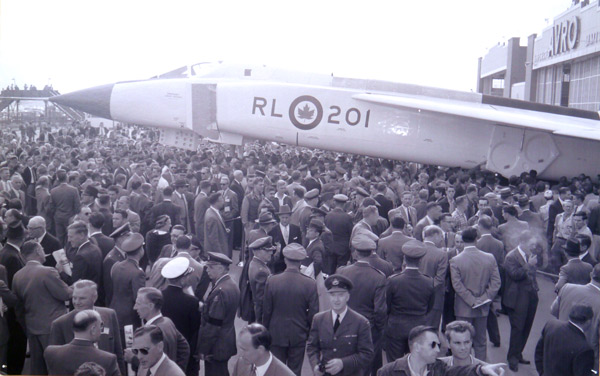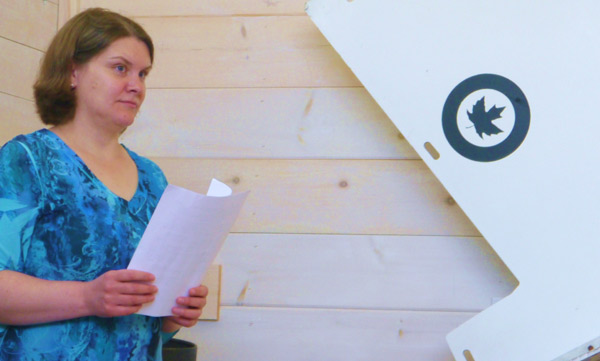Extensive preservation of Avro delta test vehicle recovered from County’s south shore
Administrator | May 25, 2024 | Comments 0
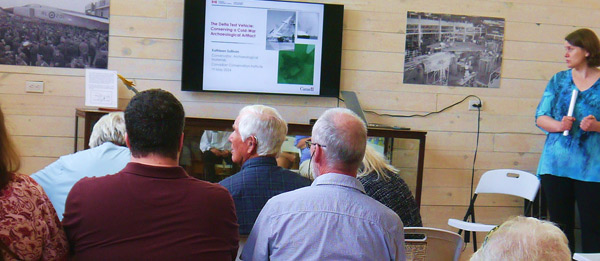 Story and photos by Sharon Harrison
Story and photos by Sharon Harrison
An expert from the Canadian Conservation Institute (CCI) in Ottawa provided some fascinating insight last week into the extensive conservation and preservation efforts needed for the Avro delta test vehicle, recovered off County shores.
Held at the Mariners Park Museum on County Road 13, and hosted by the County Museums, a full room enjoyed the free presentation by the lead conservator on the project, Kate Sullivan, who provided a behind-the-scenes look at preservation efforts that went into preparing the Cold War archaeological artifact for study, and eventual permanent display.
An archaeological conservator with the CCI, Sullivan specializes in the treatment of wet and waterlogged organic and inorganic artifacts. She explained the CCI is a special operating agency of the department of Canadian Heritage – not a museum, and does not have a collection, but were created to be a resource for the Canadian heritage community.
“We examine, analyze and preserve art and historic objects and archeological artefacts from all across Canada, and it is because we serve this particular function that we ended up involved in the Raise the Arrow project.”
The talk took place in a newly-revamped part of the museum that is now housing a new exhibit ‘Searching for the Arrow, the County connection to a Canadian legend’.
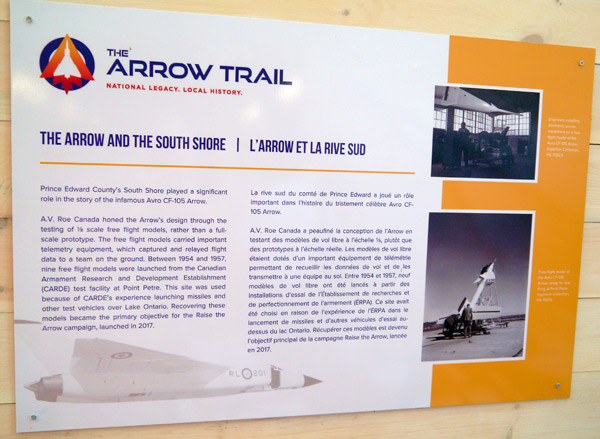 “This is really our soft launch this weekend because this exhibit (which is expected to grow) is part of the greater Arrow Trail which consists of five partners across the Bay of Quinte region, and the Arrow Trail officially opens at the end of June,” said Jessica Chase, County Museums’ curator.
“This is really our soft launch this weekend because this exhibit (which is expected to grow) is part of the greater Arrow Trail which consists of five partners across the Bay of Quinte region, and the Arrow Trail officially opens at the end of June,” said Jessica Chase, County Museums’ curator.
While the talk wasn’t about the Avro Arrow story per se, not Sullivan’s area of expertise she said, but the part of the story that is relevant she said is the fact that they built free-flight test models. Sullivan provided a fascinating, humorous and in-depth, behind-the-scenes insight into how the extensive process for Delta Test Vehicle (DTV) conservation and preservation was achieved, ensuring it could be preserved for display and study, where conservation efforts were carried out by a team at the Ottawa-based institute.
The Avro Arrow’s historical connection with Prince Edward County was most particularly highlighted in summer 2018 during the Raise the Arrow project undertaken off the County’s south shore.
It became an exciting time for many curious and interested in the project when a search for the Avro Arrow free-flight models was undertaken that summer. The models themselves were originally launched during testing from 1954 to 1956 and it had been believed by experts in the field that they may still be lying on the lake bottom, assuming they remained intact, or mostly so.
Unfortunately, and to the great disappointment of many who were so hopeful something tangible would be located, the test models were not found. However, what was discovered and recovered from the bottom of Lake Ontario during the Raise the Arrow project was a delta test vehicle (DTV) – one of three fired from the Canadian Armament Research and Development Establishment (CARDE) facility at Point Petre in 1954.
Beginning the story, Sullivan went back to the 1950s when the Cold War was underway and Canada was on the cutting edge of aerospace technology, and the Avro company were building the CF-105, the Arrow, as an inceptor plane. She explained that due to time constraints, the Avro company did not build full-scale prototypes, they built instead one-eighth scale, free-flight test models (nine of them).
“These were attached to booster rockets and most of them were launched from the CARDE range here in Prince Edward County, so somewhere out in Lake Ontario there are nine test flight models,” said Sullivan.
She said searching for the Avro Arrow test flight models has gone on since at least the late 1990s, and while there were probably searches before that, CCI only became involved in the 1990s.
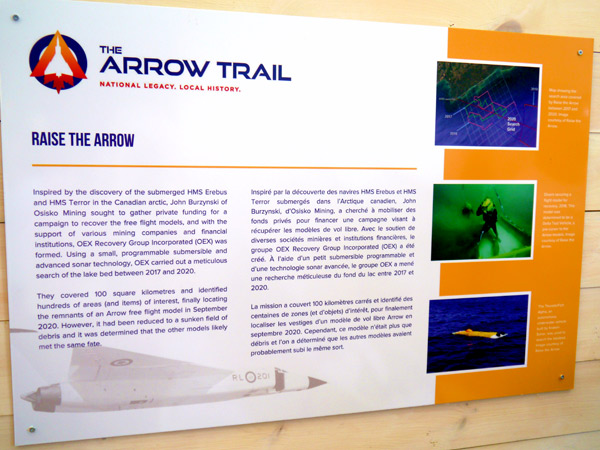 She said the most recent search efforts were made in 2017 by the OEX Recovery Group and they worked with a project archeologist and Ingenium (Ingenium is the umbrella organization that runs the Canada Agriculture and Food Museum, the Canada Science and Technology Museum, and the Canada Aviation and Space Museum, all located in Ottawa).
She said the most recent search efforts were made in 2017 by the OEX Recovery Group and they worked with a project archeologist and Ingenium (Ingenium is the umbrella organization that runs the Canada Agriculture and Food Museum, the Canada Science and Technology Museum, and the Canada Aviation and Space Museum, all located in Ottawa).
“The Canada Aviation and Space Museum (CASM) and the OEX Recovery Group had sonar survey done of the bottom of Lake Ontario starting in 2017, and this led to hundreds of targets being identified, these all had to be ground-traced where you put divers down in the water and go down and physically look at the thing you have found on your sonar scan.”
She said there are a shocking number of plane-shaped rocks on the bottom of Lake Ontario, when an actual plane-shaped object was located and the decision was made to recover it.
“We knew going in that it was not an Arrow Avro free-flight model, and it was not like it came up out of the water and everyone was shocked, this was information we already had, but it was deemed to be a key piece of Canadian aerospace history, and we thought, what an opportunity.”
Sullivan said her part in this project began in April 2018 when she started working at CCI where the project was already underway as the searching was already on-going. So, on a fine day in August 2018, Sullivan and a co-worker found themselves at the Quinte’s Isle marina boarding the Wilson T. Cooper that steamed out to the recovery site.
“The boat had a full crane on it, so they were able to drop this recovery cradle, which had been custom built, into the water, divers went down, they slid the DTV into the cradle, we had already lined the crate with snow fencing and netting because you are going to pull up throw water and you don’t want to fall to pieces as you go,” Sullivan explained, adding that co-ordinated plastic board went on underneath, along with foam and a holding strap.
“I was on board the boat as this thing was coming out of the water, and it was a very exciting day; everyone is really excited, this has been more than a year in the making, this is fantastic.”
 The first rule of archeological conservation is that if it is wet, keep it wet, she added.
The first rule of archeological conservation is that if it is wet, keep it wet, she added.
“Which is why we have a lovely plane-shaped object covered in towelling, the crate was brought on board the boat, so it is immediately soaked towelling covered and we are trying to keep it wet and we are about to head back into shore.”
When they dropped anchor for the night, the DTV remained in its crate covered in towels and a piece of plastic sheeting with a tarp over it where Sullivan said the captain of the boat kindly set off the sprinkler system so it was constantly being showered with water overnight.
The DTV made its way to CFB Trenton where the crate was off-loaded and the team was temporarily moved into a field lab that had been a seaplane hanger.
“When you are doing archeological conservation, you are told there is going to be field lab, happiness in a field lab is running water, so the fact that we had a building was really exciting, running water and they gave us the whole day.”
When the DTV was recovered from the depths of the lake, it was covered in quagga mussels (30 pounds of them) and Sullivan said there was damage to one wing (near side wing) and there was also damage to the fuselage directly behind the nose cone, and it was missing two out of three of the tail fins. One of the tail fins had been found nearby and came up separately, but she has no idea what happened to the other two.
The plan was for them to stay at CFB Trenton for about a week and be joined by a team from CCI where before-treatment photography would be done and they would examine the DTV, assess the damage and do some initial analysis before cleaning commenced.
“It was not going to be possible to do a full conservation treatment in Trenton, this was going to take months and we were going to need the proper lab space to do this, so we were going to have to transport the DTV back to Ottawa, and due to the size of the crate, the weight of the DTV and the fact that CCI unfortunately does not have a crane (and the hallways are only about so wide), we were not going to be able to do the rest of the work at CCI.”
As they had partnered with Ingenium, it was agreed they would take the DTV to the Aviation Museum as they have the space with a whole restoration hanger where the team can set-up.
“Here’s the catch, you cannot bring dead and dying quagga mussels into a conservation space of a museum, they are a biohazard and we are going to end up attracting pests into the collection.”
The first step was to get all of the mussels off, which meant hand cutting all of the mussels off, mainly with scalpels, some dental tools and wooden skewers to remove as much as the mud and sediment as possible.
“Through all of this, we are still trying to keep it wet and we weren’t quite sure what the state of affairs were regarding if there was any salt contamination. Despite Lake Ontario being a fresh water lake, salt is a great enemy to metals and there’s been a great amount of road salt applied around Lake Ontario, so there’s a bit higher of a salt content than you would get in a freshwater lake.”
Next, they were able to get x-rays of the DTV done on the very last day they were in Trenton.
“We really don’t know what’s going on with the fuselage and it probably has equipment in it and we don’t know what the state of affairs is, so this will be great, and not being able to get into the building at CCI, we will not be able to use the x-ray equipment we have there,” she said.
“They had this wonderful portable x-ray tube, they had a horrible digital x-ray developer, so they show up with a computer, so we ended up with x-rays of the entire fuselage, this was great and as a conservator you always want more information about your object and what’s going on, especially with a metal object, especially something that probably has electronics in it, and what’s going on inside.”
“You have to keep in mind at this stage, we didn’t know exactly what this was; we knew it wasn’t a free-flight test model, but who made it, where it came from, we were not sure what’s going to be inside of it.”
She confirmed they didn’t know which of the three DTVs it was, and it had no serial number on it for identification.
The information boards at the new exhibit at the Mariners Park Museum indicate that as A.V. Roe representatives were present for the firing of at least one of the DTVs, it is very possible that these items were used to inform the launch and design of the Arrow free-flight models.
The x-rays showed that there was a board inside with electronics, and after it was cleaned of the mussels, original orange paint was revealed “and we were really not anticipating that there would be a lot of original paint left and it meant our conservation treatment plans had to change”.
Next was the trip back to Ottawa where the DTV was transported by transport truck with Sullivan and her colleague following in their car, in contact with the transport truck driver throughout.
Arriving at the Canada Aviation and Space Museum, they got a day in their lab which is a massive hanger in their conservation space and the cleaning began where the body of the mussels with the shells were cut off the DTV, but Sullivan explains they were left with what is called the muscle biases which is the attachment part.
Initially, the plan was to use dry ice blasting (which is not dissimilar to sand blasting) to do the cleaning, as dry ice blasting is a much more gentle procedure effective at cleaning off the muscle biases and sediment and corrosion.
“We did determine very quickly that if we had attempted to use dry ice blasting we would have stripped all the original paint off,” she said. ”This is where conservation differs from restoration, so in restoration you are trying to bring something fully back to life, you want it to look brand new and shiny, in conservation this is not how this works. We tend to acknowledge that the object has lived a life and we do like to maintain our original components.”
Involving substantially more manual labour than first anticipated, they spent hundreds of hours spraying mussel biases very carefully so as not to damage the original paint underneath.
A bit of disassembly came next since the x-rays showed there were electrical components on the inside, so the first thing was to take the hatch covers off. The entire fuselage was full of sediment and mud, which they knew they couldn’t leave as it would cause degradation.
The decision was made to take the nose cone off, where one of the conservators drilled out the original screws as they wouldn’t turn.
“We were using wooden wedges into the crack between the nose cone and the fuselage and we didn’t want deadblows penetrating, and used pretty much every trick in the book and eventually we did manage to separate the nose cone from the fuselage.”
“The other great thing about having the x-rays was that we already knew that there was no wires that went from the fuselage to the nose cone, and so we were not concerned that by pulling the nose cone we were going to cause damage to the electrical components.”
The next part was removing the telemetry board.
She said it did end up being possible to unscrew the originals screws that were holding the telemetry board to the fuselage and it took “an initial pull to break that crusted corrosion and that night we were able to pull the telemetry board out, came out as slick as can be, out of the fuselage”.
She said the telemetry board went back to CCI for the remainder of the treatment and they finished treating the fuselage.
“We found this very interesting putty material in the tail, this was a mixture of titanium dioxide and poly alpha-methylstyrene, which may have been a tamping clay, and this is where the tail would have been connected to the booster rocket that was fired, but honestly it was like finding silly putty in the back of the plane which was not entirely expected.”
Sullivan explained that with conservation, there’s not always tools to use in conservation, so they to borrow from other fields as they go.
Next, they needed to dry the DTV, all while trying to keep all of the paint flat using conservation materials with weights on top, where they then glued the paint down, using an adhesive with a lot of solvents in it. That process brought its own challenges as they were using respirators for safety and had massive extraction fans going intermittently. But the fans brought in very cold February Ottawa air which made the glue so cold, it would not stick.
They successfully got all the paint stuck down on one side, then flipped it over and did it again on the other side, “and what was great about this project was most of the paint was in the nose cone, so we could flip it over”.
“And then we were done, and it was so exciting, we are ahead of schedule, everything is great, and we flip it over to shoot the other side for the after-treatment photos and that’s when we hear it, glug, glug, glug… and it’s like, no, oh no, no, no, no!”
They managed to determine that there was water inside the intact wing.
“I have no idea how we did not hear it doing numerous flips beforehand, but it was what it was and you can’t leave water in an object, it will corrode,” Sullivan said. “The most corroded area is down at the bottom of the wing, so it would be great if we can get all the water flow down there.”
A support was rigged up and they stood it up on its end.
“I had the lovely task of actually poking holes in the corrosion into the wing and we drained out about a litre of water,” she said. “It does speak great things to 1950s engineering that they managed to get a watertight wing (not sure why it had water in there to begin with) and we left it standing upright for three days.“
All that’s left now to deal with is the telemetry board which was x-rayed revealing an electrical component and three batteries, two on the bottom and one on the top, as well as some sediment and corrosion.
Then cleaning began, again.
“What was cool about this was once we got off all the sediment and the corrosion, it was actually possible to unscrew all the original little nuts and bolts and remove the battery components on the underside.”
They only ended up having to cut one plier to detach the battery and then all of the batteries were in paper packets.
“The one excitement was when dealing with the batteries and getting the batteries out of the paper packages was really neat, and then little beads of mercury rolled out.”
The mercury hadn’t shown up on the x-ray.
“Mercifully, they were in a tray in a fume hood because we were trying to be cautious, so I know I didn’t contaminate my entire lab with mercury.“
She said the really impressive part of this was how much electrical tape it involved and it was still sticky, adding “there’s something to this 1950s electrical tape”.
Conservation efforts were finally completed by the end of March 2019.
Sullivan stressed that the presentation was a summary of the project, noting how this kind of project is a massive undertaking.
“It doesn’t always look like much in the case, but there is always a whole team of people behind this.”
The recovered and conserved DTV is currently on display at an exhibit at the Canada Aviation and Space Museum in Ottawa.
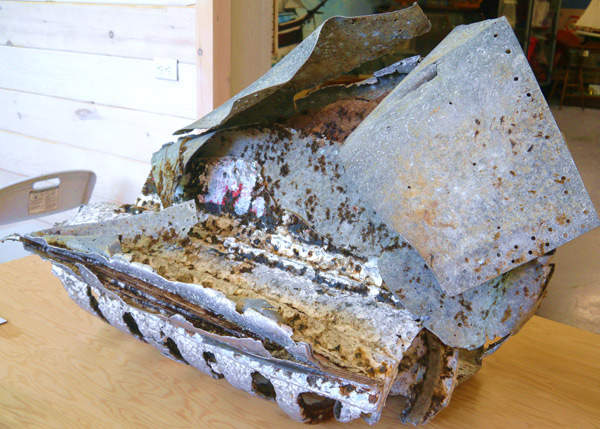
Booster rocket component, on display at the Searching for the Arrow exhibition at Mariners Park Museum.
New trail route would honour national legacy and local history of Avro Arrow
Search finds one Avro Arrow model off shore of Prince Edward County
Filed Under: Arts & Culture • Featured Articles • News from Everywhere Else
About the Author:



